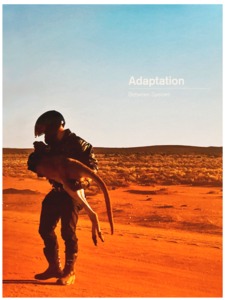Adaptation: Between Species
Reckitt, Helena. 2010. Adaptation: Between Species. [Exhibition Catalogue]
![[img]](https://research.gold.ac.uk/33621/1.hassmallThumbnailVersion/Screenshot%202023-06-01%20at%2014.14.36.png)
|
Image
Screenshot 2023-06-01 at 14.14.36.png - Supplemental Material Download (1MB) | Preview |
|
|
Text
Adaptation Catalogue_Helena Reckitt.pdf - Published Version Permissions: Administrator Access Only Download (1MB) |
Abstract or Description
Catalogue essay exploring the human desire to connect, channel and submerge with other species through interaction with non-human animals and the natural world. It discusses how artists explore what forms of communication, miscommunication, intimacy and exchange ensue.
As the industrialized world further encroaches on the natural world, species live in ever-closer proximity. Yet many people feel profoundly cut off from natural environments and from their own animal natures. This deep longing to connect with non-human life forms is reflected in contemporary phenomena ranging from the boom in pet ownership and the widespread anthropomorphism in popular culture to the upsurge in vacations that promise to transportation to unspoiled lands.
Yet despite the deep-seated human sense of alienation from nature, all animal species are in fact closely related. For instance, as Donna Haraway notes in her book When Species Meet, 90 percent of human cells are filled with the genomes of bacteria, fungi, protists, and such, with only 10 percent comprising human genomes. The essay explores this commonality between the species and considers the various forms of intelligence and knowledge they share. It also asks what human interactions with other species reveal about their animal natures. Highlighting the urge to observe, touch, live with, and mimic other species, the essay delves into the intimate and, at times, uncanny fusions that result. From another perspective, it looks at the facility that animals have in adapting to our domestic and urban environments, including the ability to "train" their masters.
Coinciding with the United Nations International Year of Biodiversity, the catalogue considers how adaptation functions as a form of biological and cultural survival. It also builds on Roger Caillois’s 1935 essay “Mimicry and Legendary Psychasthenia” – which was central to Surrealist thought as well as to Jacques Lacan’s theories of the Mirror Stage – to think through the spatial, aesthetic and psychological nuances of camouflage and assimilation. Above all, the essay aims to take a realistic view of human/non-human dynamics: it acknowledges the unbalanced and exploitative power relations that too often characterize our society’s attitudes toward other life forms.
|
Item Type: |
Exhibition Catalogue |
| Additional Information: |
The essay considered work by artists Allora & Calzadilla, Francis Alÿs, Cory Arcangel, John Bock, Olaf Breuning, Marcus Coates, Robyn Cumming, Mark Dion, FASTWÜRMS, Shaun Gladwell, Lucy Gunning Short texts on artists were written by Colin Crawford, Jon Davies, The essay received the 2011 Ontario Art Galleries Curatorial Writing Award. |
| Departments, Centres and Research Units: |
|
| Date: |
1 June 2010 |
| Event Location: |
The Power Plant, Toronto, Canada |
| Date range: |
19 June–12 September 2010 |
| Item ID: |
33621 |
| Date Deposited: |
01 Jun 2023 14:35 |
| Last Modified: |
01 Jun 2023 14:35 |
|
URI: |
View statistics for this item...
 |
Edit Record (login required) |

 Tools
Tools Tools
Tools
